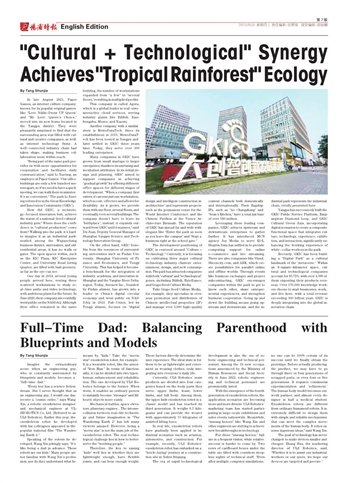By Tang Shunjia
Imagine the extraordinary scene when an engineering guy, who is constantly surrounded by blueprints and models, becomes a "full-time dad."
"Every boy has a science fiction dream. But I never thought that as an engineering guy, I would one day receive a 'cosmic order,'" says Wang Xin, a robotic exoskeleton designer and mechanical engineer at ULSROBOTICS Co, Ltd. (Referred to as ULS Robotics). Earlier this year, the exoskeleton robot he developed with his colleagues appeared in the popular national film "The Wandering Earth 2."
Speaking of the robots he developed, Wang Xin jokingly says, "It's like being a dad in advance. These robots are our kids." Many people are not familiar with Wang Xin's profession, nor do they understand what he means by "kids." Take the "movie star" exoskeleton robot, for example. It is a wearable robot, like the armor of "Iron Man." In terms of functionality, it can be divided into two types: human enhancement and rehabilitation. The one developed by ULS Robotics belongs to the former. When worn, it enables an ordinary person to instantly become "stronger" and lift heavy objects more easily.
Mechanical battles, space elevators, planetary engines... The intense collision between real-life technology and future imagination in "The Wandering Earth 2" has left many viewers amazed. However, being a "movie star" is not the main job of the exoskeleton robot. The real technological challenge lies in how to better serve the "working people."
Therefore, the key to raising "kids" well lies in whether they are lightweight enough, have flexible joints, and can bear enough weight. These factors directly determine the user experience. The ideal state is for them to be as lightweight and convenient as wearing clothes, truly integrating into everyone's daily life.
Currently, ULS Robotics' main products are divided into four categories based on the body parts they serve: upper limbs, waist, lower limbs, and full body. Among them, the upper limb exoskeleton robot is a classic model and has reached its third generation. It weighs 6.5 kilograms and can provide the wearer with approximately 15 kilograms of assisted lifting force.
In real life, exoskeleton robots have gradually been applied in industrial scenarios such as aviation, automotive, and construction. For example, recently, ULS Robotics' exoskeleton robot has embarked on a "brick-laying" journey at a construction site in Xuhui Binjiang.
The era of rapid technological development is also the era of robotic engineering and technical personnel. Among the 18 new occupations announced by the Ministry of Human Resources and Social Security in June 2022, robotic engineering and technical personnel are prominently listed.
With the emergence of the fourth generation of exoskeleton robots, the application scenarios are becoming more and more diverse. ULS Robotics' marketing team has started participating in large-scale exhibitions and sales events nationwide. Meanwhile, "unsung heroes" like Wang Xin and other engineers are striving to achieve new breakthroughs in technology.
For these "unsung heroes," failure is a frequent visitor, while relative success is harder to come by. Two rows of cardboard boxes under the table are filled with countless sleepless nights of technical staff. "Even after multiple computer simulations, no one can be 100% certain of its success until we finally obtain the prototype. Before actually producing the product, we may have to go through three or four generations of scrapped parts, or even four or five generations. It requires continuous experimentation and 'refinement.' The human body model becomes our work partner, and almost every designer is half a medical student. Exoskeleton robots are different from ordinary humanoid robots. It is extremely difficult to design them with simple and reliable mechanisms that can meet the complex movements of the human body. It relies on some ingenious ideas," said Wang Xin.
The goal of technology has never changed: to make devices smaller and cheaper. Zhang Hua, the marketing director of ULS Robotics, said, "Whether it is to assist our industrial workers or our users, we hope our devices are targeted and precise."

